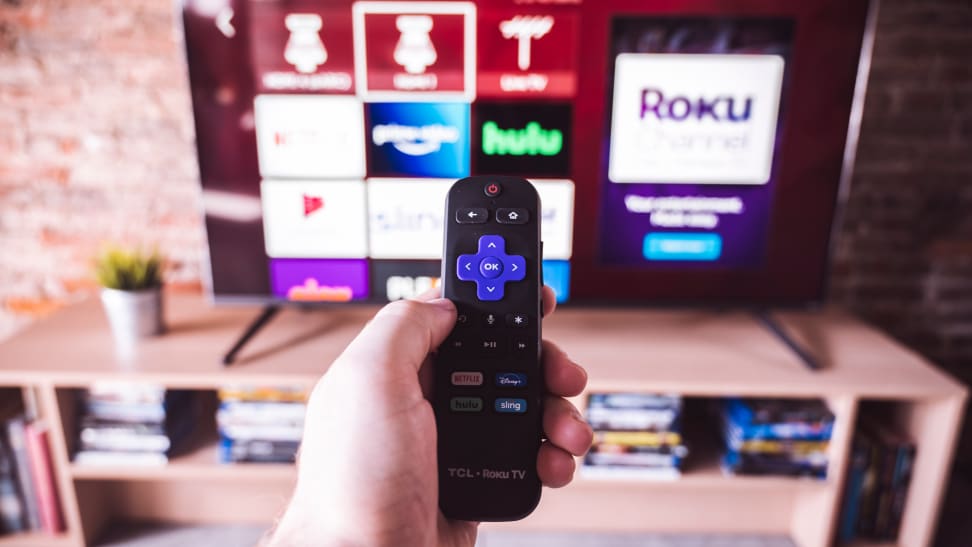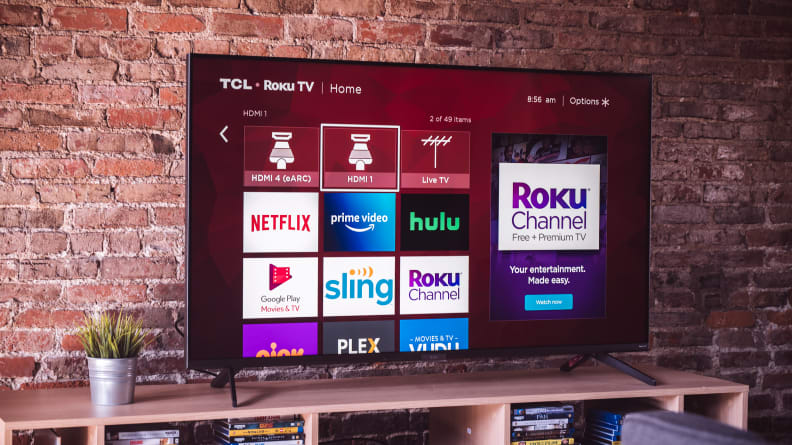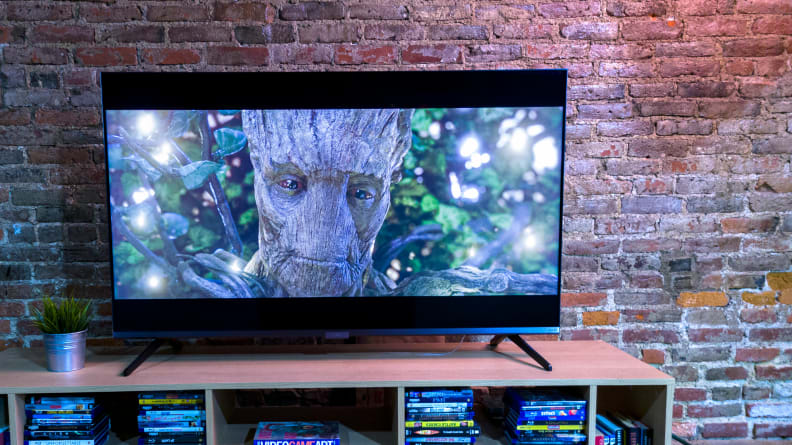TCL 5-Series vs TCL 6-Series: Which Roku TV is best?
Two popular TCL Roku TVs duke it out in a head-to-head matchup.
 Credit:
Reviewed / Jackson Ruckar
Credit:
Reviewed / Jackson Ruckar
Products are chosen independently by our editors. Purchases made through our links may earn us a commission.
From the outside, the TCL 5-Series and the TCL 6-Series—two of TCL’s most popular TVs—look almost identical. If you place their spec sheets side by side, you’ll notice plenty of similarities, too. In fact, at first glance, the only major difference between the 5- and 6-Series seems to be their respective price tags. So, what’s going on here?
The truth is, while these two budget-friendly smart TVs have more similarities than differences, those differences are significant when it comes to overall performance, and understanding what sets them apart will ultimately help you decide which will be the best value for your dollar. Let’s get into it.
Buy the TCL 5-Series (2020) at Amazon
Buy the TCL 6-Series (2020) at Amazon
Price
While these TVs were originally released in 2020, they’re technically still the latest Roku TVs of their respective makes and models from TCL. There's a newer, higher-end TCL 6-Series with 8K resolution, as well as 4K 6-Series and 5-Series TVs with Google TV, but if you're looking for a 5-Series or 6-Series TV with Roku, these are the two to shop for. We enjoy Google TV smart platform fine, but not as much as Roku. With that in mind, let's take a look at how these TVs stack up.
Other than the 5-Series' 50-inch model, these two series share screen sizes in the form of 55-, 65-, and 75-inch variants. While you might find various sizes at discounts in stores and across the web, here's how they shake out in terms of official retail price:
TCL 5-Series:
- 50-inch (TCL 50S535), MSRP $399.99
- 55-inch (TCL 55S535), MSRP $449.99
- 65-inch (TCL 65S535), MSRP $629.99
- 75-inch (TCL 75S535), MSRP $1,099.99
TCL 6-Series:
- 55-inch (TCL 55R635), MSRP $650
- 65-inch (TCL 65R635), MSRP $900
- 75-inch (TCL 75R635), MSRP $1,400
The difference in cost amounts to around $200 to $300, depending on which sizes you’re comparing. As you’ll learn, there are justifiable reasons to explain this gap in price, but in terms of pure greenbacks, the 5-Series is the one to go with if you're just looking to save money. We should add that, as these TVs get older, their prices have continued to drop.
Our pick: TCL 5-Series
Design

Regardless of which you choose, you can rest easy knowing you're investing in a terrific smart platform.
If you turned these TVs off and set them up side by side, you probably wouldn’t be able to figure out which was which. Both the 5-Series and 6-Series feature a moderately thick black panel flanked by boomerang-shaped feet—a style familiar to anyone who’s spent some time in the TV aisle in recent years.
In fact, I doubt even TCL could tell you which was which if they weren't powered on and playing content. The 6-Series is a bit thicker at the side due to its enhanced backlight (more on that below), but they're otherwise identical, right down to the AV ports. Both net you four HDMI inputs, a single USB 2.0 port, and LAN (ethernet), cable (RF), optical audio out, and 3.5mm input ports. They're even arranged identically in a cutout on the side of the panel.
Finally, both include a standard TCL Roku TV remote control—identical down to the buttons.
Our pick: Draw
Features and smart platform

Both the TCL 6-Series (seen here) and the more affordable TCL 5-Series come with the Roku smart platform built right into the TV's software, and Roku's features work the same way on both TVs.
Not only are they "dressed" super similarly, the 5- and 6-Series also deliver a bunch of the same features. Whether you opt for the 5-Series or spend a bit more on the 6-Series, you’ll be locking down a smart TV with our favorite smart platform built right in. Both the 5- and 6-Series are Roku TVs, which means they come with Roku software right out of the box—no streaming box required.
Roku software is famously easy to set up and use, and its Channel Store allows users to download and install a nigh limitless amount of content, including all the most popular streaming apps: Netflix, Hulu Plus, Prime Video, HBO Max, and Apple TV+.
In terms of other features, both series offer full HDR support (Dolby Vision, HDR10, and HLG), Dolby Atmos pass-thru (via eARC), and Google Assistant/Amazon Alexa integration. Just like in terms of their physical appearance, the 5- and 6-Series TVs are almost identical in terms of their software and feature compatibilities.
Our pick: Draw
Performance

The 6-Series (seen here) is much, much brighter than the 5-Series, making it a better choice for cinephiles or folks with bright living rooms.
Arguably the most important distinction between these two TVs has to do with panel hardware. The 6-Series features TCL’s Mini-LED display technology, which allows for tighter contrast control than what you get with traditional full-array LED displays, like the 5-Series. As an example, the 55-inch TCL 6-Series is equipped with 128 LED zones, but the 55-inch 5-Series is only rolling with 48 LED zones. This means that the higher-end 6-Series is better equipped at balancing bright and dark picture elements and limiting light bloom.
Another major difference that folks should be aware of—particularly gamers and sports aficionados—is native refresh rate. In a nutshell, this figure, presented in Hz, represents the amount of times a display refreshes every second.
Most contemporary TVs—the TCL 5-Series included—refresh 60 times per second (60 Hz). Higher-end TVs tend to refresh 120 times per second (120 Hz). Despite being significantly less expensive than most high-end flagships, the TCL 6-Series offers a native refresh rate of 120 Hz, meaning it supports native 60 FPS content and, ultimately, native 120 FPS content (up to a resolution of 1440p). In general, the 6-Series is just better at displaying motion, too—even motion that clocks in at 24 and 30 FPS. Fast-paced content, especially action movies and live sports, will simply look better on the 6-Series.

The 6-Series (seen here) features Mini-LEDs, which allows for tighter contrast control than what you'll get with the 5-Series.
And while we’re on the subject of gaming, it’s worth noting that the 6-Series also comes with a suite of gaming enhancements that will help folks get the most out of their Xbox Series X or PlayStation 5. It supports Auto Low Latency Mode (ALLM) and Variable Refresh Rate (VRR), two features that, respectively, automatically initiate low-latency gaming and prevent screen tearing.
Another key metric you can use as a point of reference is peak brightness. While the 6-Series offered up a reading of 960 nits when displaying a 50% white window, the 5-Series topped out at about 398 nits while displaying that very same test pattern. The 6-Series gets brighter in SDR than the 5-Series gets in HDR. It’s almost silly.
And although the 5-Series covers a respectable 91% of the extra-wide HDR color gamut (DCI-P3), the 6-Series covers 96% of the expanded color gamut. If you were to watch the same content on these TVs side by side, you’d almost certainly find the colors of the 6-Series’ picture to be richer.
Our pick: TCL 6-Series
And the winner is...
The 6-Series is a significantly better performer than its less expensive little sibling, regardless of how you cut it. In our lab tests, the 6-Series best the 5-Series in nearly every performance category, from contrast to color. That said, the 5-Series has the edge when it comes to cost, as it tends to be $200 to $300 cheaper.
So ask yourself this: Does $200 to $300 warrant a better, brighter picture, improved motion handling, and a suite of gaming-related enhancements that will affect your next-generation gaming experience?
If you don’t plan on investing in a PlayStation 5 or Xbox Series X, or if you don’t particularly care about picture quality, the TCL 5-Series is probably a better choice. If you own (or plan on owning) an Xbox Series X and/or a PS5, or if just want the best possible picture between the two, the TCL 6-Series is undoubtedly worth the extra dough.
One final note: If you’re leaning towards the 5-Series but plan on placing your new TV in a room that gets a significant amount of daylight or artificial light, I would urge you to consider splurging on the 6-Series, which, on average, gets about two and a half times as bright as the 5-Series. It’s a step up in price, but trust me: your eyes will thank you.
Buy the TCL 6-Series at Amazon
Buy the TCL 6-Series at Amazon
The product experts at Reviewed have all your shopping needs covered. Follow Reviewed on Facebook, Twitter, Instagram, TikTok, or Flipboard for the latest deals, product reviews, and more.
Prices were accurate at the time this article was published but may change over time.


